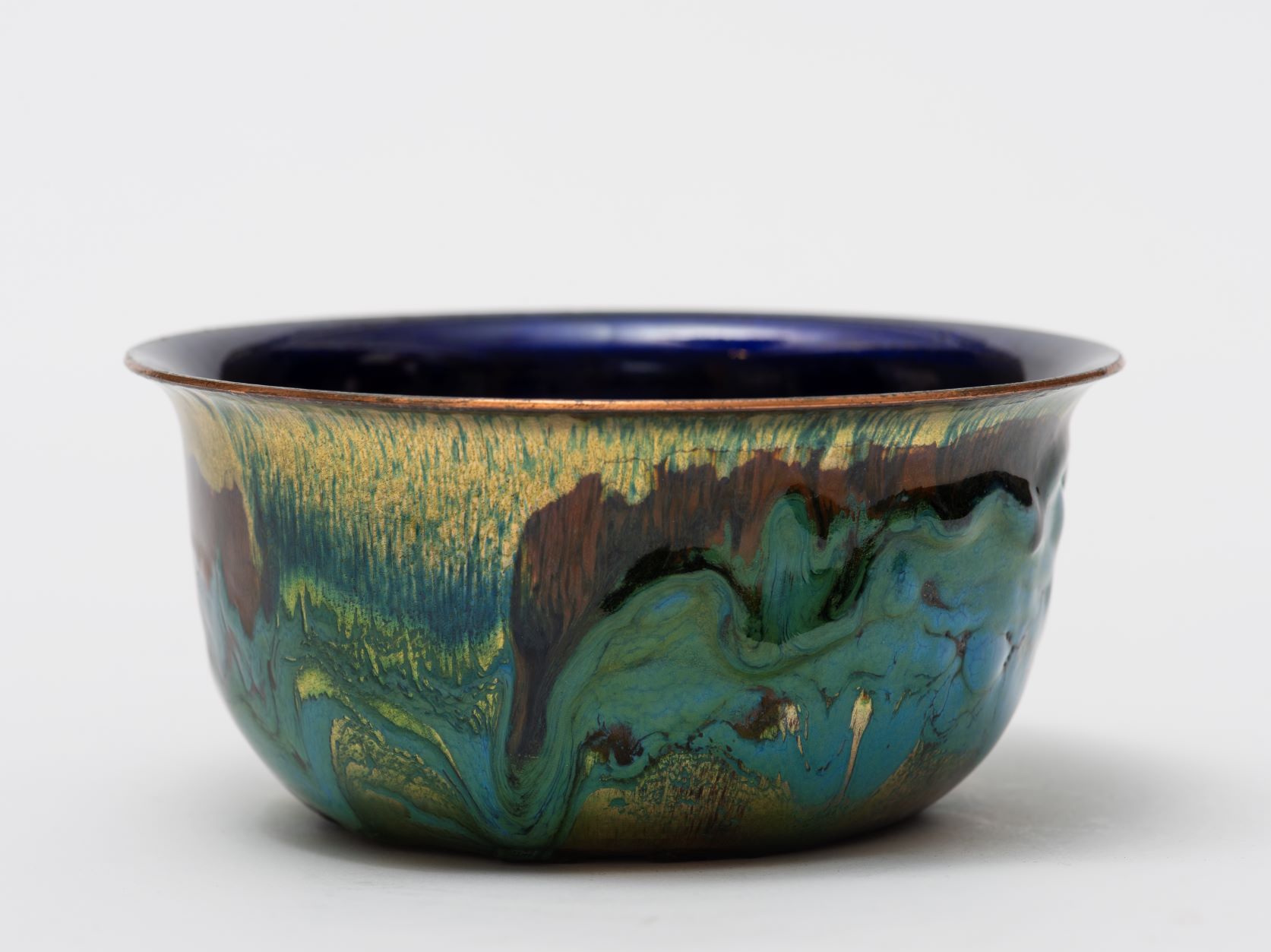Walton on Lancaster Bowls
Castlemaine Art Museum holds a small but significant selection of locally created enamel work, including a selection of work by enamelist and painter, Jan Lancaster.
In her second Reflection on Lancaster's enamel work, writer Robyn Walton, one of our esteemed volunteers, discusses a series of bowls currently on view in the Museum as part of the Reflections exhibition. Walton's first Reflection on Lancaster's work can also be viewed here.

Robyn Walton on Jan Lancaster Bowls
CAM is fortunate to have a selection of the studio enamels that Castlemaine artist Jan Lancaster made during the 1970s and early 1980s. Explaining how she came to take up enamelling, Lancaster says she turned to craftwork in the early 1970s after focusing on painting in the 1960s and having her paintings exhibited. She found she could not relate to the text-based work that had become prevalent in painting circles – “Modernism seemed to have reached a dead end” – and thought using her craft skills within the context of the craft renaissance could be a way forward for her.
In partnership with two friends, Lancaster opened a crafts workshop and gallery within the Argyle Arts Centre in The Rocks, Sydney, in the early 1970s. In the late 1970s Lancaster moved to Victoria but continued selling and exhibiting in NSW, the ACT, Victoria, and Queensland.
Enamel is powdered glass and unfortunately by the early 1980s Lancaster was developing health problems attributable to the glass particles she breathed in (despite wearing a mask) and to heavy metals exposure. Lancaster reluctantly gave up enamelling in 1982-83, returning to her painting practice.
CAM’s Lancaster display includes four decorative bowls made in 1980: a single bowl and a group of three almost identical bowls. All could be put to functional use or simply displayed.
The individual bowl is described by Lancaster as a sugar bowl, although it exists independently of a matching cream or milk jug. It measures approximately 5cm high and 10cm diameter at the mouth, has a slightly everted rim, and has the maker’s standard signature, J.L., on the base.
The sugar bowl’s outer enamel colouring is predominantly turquoise, with other shades in the blue spectrum complemented by a warm russet. Its interior is a deep, uniform blue: lapis lazuli. Around the rim the copper glows, the artist having filed back the edge to expose the metal.
The turquoise crackle enamel forms a dynamic wave-like or dragon-like pattern around the vessel and is in raised relief, giving texture and an irregular silhouette rather than the expected smooth surface.
With every Lancaster bowl being hand prepared and separately high-fired, it would be impossible to create sets of totally identical bowls. However, Lancaster addressed the task of making bowls that looked similar, and the set she donated to CAM is a beautiful example of slightly modulated differences working in harmony.

Each of the three bowls in the set is about 5cm high and 10cm in diameter at the mouth. Again, the predominant external colour is turquoise, and the interiors are uniformly lapis blue. This time the external colour is smooth textured but mottled, and it shades from darker at the top to lighter at the base. At the rim of each bowl, filing has exposed the copper base metal.
Lancaster explains she drew lines and motifs (sgraffito) on the set of bowls using a fine implement such as a dental instrument or the pointed end of a brush handle. Somewhat wobbly black lines form irregular circles on the turquoise ground.
For thousands of years circles and mandalas have been used in various spiritual traditions for purposes of focusing the attention, aiding meditation, and establishing sacred space. Lancaster’s use of the circle may derive from the affinity she felt with Zen. In Japanese Buddhism a circular form (the enso) is hand-drawn in black with just one brushstroke and within the space of a single breath. It may be an imperfect circle, with the start and end of the brush stroke not meeting precisely; this represents the acceptance and beauty of imperfection. Or it may be a completed, whole circle, indicating the desire for perfection.
The enso signifies a moment when the mind is free to let the body create. Ideally the person making the circle is in a condition of mental and spiritual completion, and the action of making the circle is a spiritual practice. There are associations with enlightenment, strength, elegance, the universe, and the void. Lancaster found that Japanese clients were especially appreciative of her enamelled bowls and liked to buy them annually as gifts.
In making all four bowls, Lancaster set herself professional challenges, particularly in the specialist area of extremely high temperature firing. Describing the enamelling process, Lancaster tells how the surface of the piece is prepared with a mix of glue and water sprayed onto the piece and then the enamel powder shaken on. For the firing, Lancaster says, she placed each item on a trivet, then placed the trivet on a wire grill and used a long wooden-handled metal paddle to place the grill in the kiln.
Firing was an arduous physical process, she recalls, and there was tension about outcomes, especially with steep-sided pieces such as the sugar bowl, which were more difficult to fire without problems. For this sugar bowl, Lancaster explains, she used very high temperature firing and fired the object for a longer time than is usual. Both moves were risky, with melting of the enamel the hardest thing to manage; she had to prevent the slumping process from proceeding to total meltdown, which would spoil the piece.